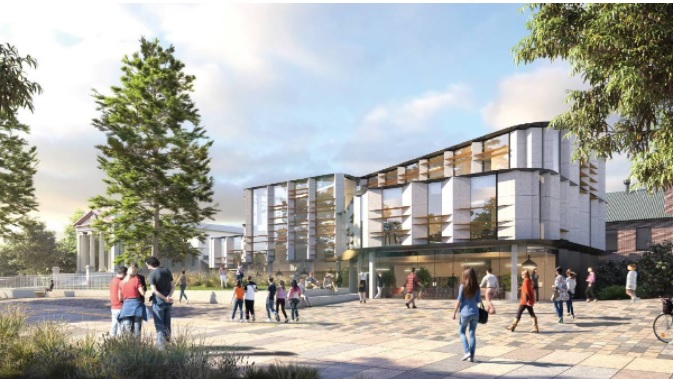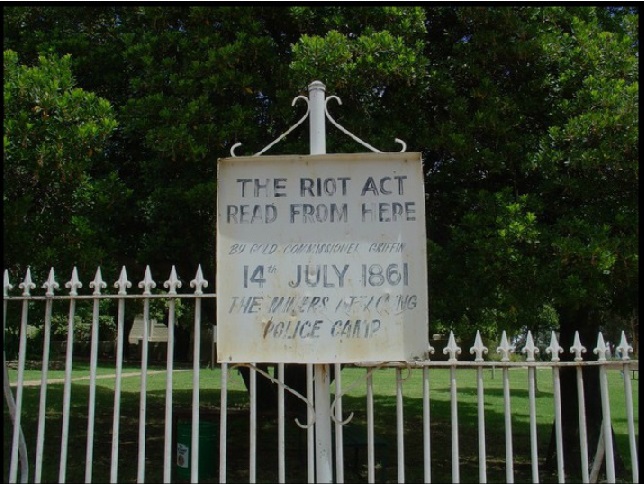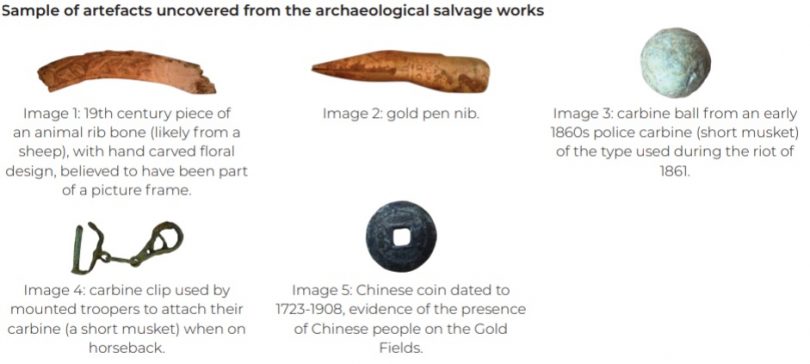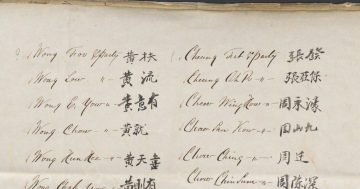
An artist’s sketch of the Lambing Flat confrontation between police and European miners at the height of the gold rush in the early 1880s. Image: Supplied.
As a spot already mired in controversy, it’s hardly come as a surprise to the people of Young the site of the town’s new community library is now an archaeological dig.
Most expected an underground tunnel, but an old rubbish pit and an intact bottle signalled a stop work on construction just as it began in March 2021 along the southern end of the town’s landmark heritage-listed Carrington Park, which borders the local high school.

Young’s stately old courthouse was designed by colonial architect James Barnet. It opened in 1888 and has served as the assembly hall at Young High School since 1925. Photo: Supplied.
The ensuing months of quiet digging, overseen by Heritage NSW, has revealed a trove of hundreds of objects – all stark reminders of the town’s bloody beginnings.
Welcome to the centrepiece of arguably the most serious civil disorder that has happened in Australia, involving more people and lasting much longer than the Eureka rebellion at Ballarat six years earlier – The Lambing Flat Riots.
A fairly large stone’s throw uphill from where gold was first discovered in a creek bed, this is a place of international renown and one that many locals argued was not ideal for the new community facility.
Debate has raged as funding for a new library for the high school, announced in 2017, eventually segued with the crumbling nature of the town’s existing CBD-located library resulting in an unconventional arrangement that would see the new town library located on high school land.
Some distance from the town’s centre, the jointly funded $25.5 million NSW Government and Hilltops Council project now called the Young High School Joint Use Library and Community Facility was, some in the community believed, one that flouted their needs.

An artist’s impression of the new Young High School Joint Use Library and Community Facility. Image: Infrastructure NSW.
Local historian Brian James said he felt the town’s residents had never been given the opportunity to express their opinion about what Hilltops Council and the Department of Education intended to do on the site.
“The local people who use the library are the ones who know what they want and what they need and where they need it,” he said at the time.
“Nothing should be done until the public have been given all the information and the correct information. And what is going to be the true story of the creeping monster eating up more and more of the park,” he said.
As recently as June 2020 the matter came before parliament – at the behest of Shadow Minister for Regional NSW Mick Veitch MLC – who wanted the documents relating to the project made public.
“I think there should be transparency around the project. Parliamentary scrutiny on projects such as this is essential. I look forward to the Government tabling these documents in the NSW parliament,” he said.
It was also Mr Veitch –a deputy mayor of the former Young Shire Council – who backed investigations of the heritage value of the site.
Here, locals familiar with the simple white sign on the fence of Young High School know, without reading, this is a place of significance.

Digging at the construction site has unearthed remnants that date back to the town’s days of early settlement. Photo: Supplied.
In faded black writing the words – “The Riot Act read from here by Gold Commissioner Griffin 14th July 1861 The Miners Attack Police Camp” – understate the facts.
It was more like attacked and burned the police camp to the ground after a swag of attacks against Chinese gold miners in the various gold diggings around the 18-month-old settlement, with its population of 20,000 people, had culminated in the arrest of several of the European ringleaders.
Fuelled by the rumour 2000 more Chinese had docked in Sydney bound for the NSW goldfield, the civil unrest reached fever pitch. The reading of the Riot Act – the one and only time it was read in NSW – had little impact and that night the local police and magistrates released the prisoners, packed up their possessions and fled town.
The courthouse, constructed of three-inch thick sawn timber, and police camp were immediately burned down.
Five years later a grand new courthouse would be built in its place. In time it became the assembly hall for the high school but former students will insist a prisoner transfer tunnel connected it to the town’s old gaol, now the Young TAFE campus.
Despite ground penetrating radar scans to depths of four metres in two locations, no evidence of a tunnel was found.
But the old rubbish pit and intact glass bottle did stop work, the trowels came out and according to School Infrastructure NSW, an archaeological team has recovered and processed more than 4000 historical artefacts so far, with most dating from the 19th century.
Recently, members of the public were invited to view some of the items including fragments of glass and ceramics, buttons from police uniforms, a ceramic doll leg, an animal rib bone (likely from a sheep) with a hand-carved floral design, a Chinese coin, carbine balls and clips and the nib of a gold pen.

Just some of the remnants recently on public display. Photo: School Infrastructure NSW.
Some of these are believed to be associated with the Lambing Flat riots.
The archaeological team has also recently started working with local Aboriginal groups on excavations for Aboriginal stone artefacts in an area north of the old courthouse.
The reconciliation tree sits nearby, keeping company with old wizened trees that have survived the changing times.
On a site steeped in history harking back to the Wiradjuri people, there has been the suggestion a barely advertised two-hour public viewing does an injustice to the town’s heritage.
According to School Infrastructure NSW, the archaeological team will finish the salvage works, and preparation works will then begin to lay the concrete slab for the new joint use library.












